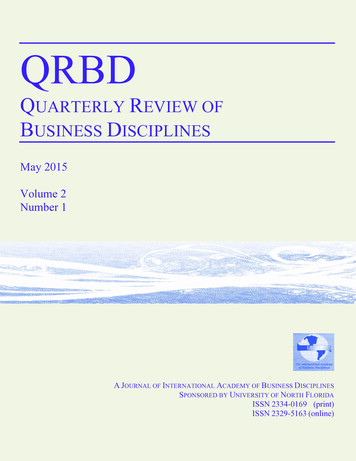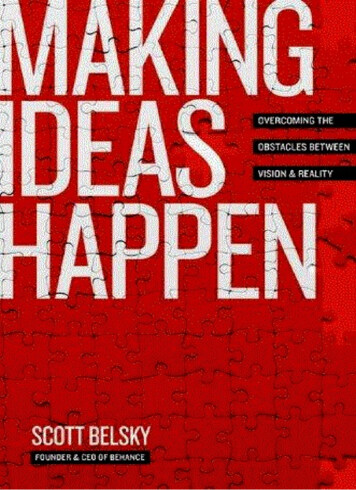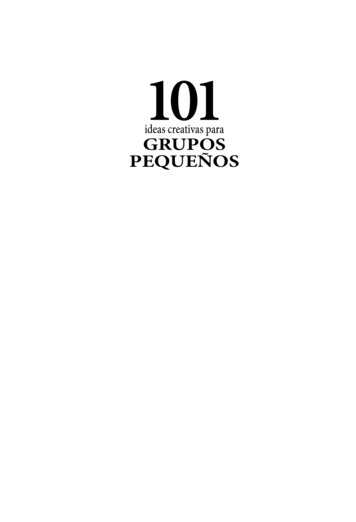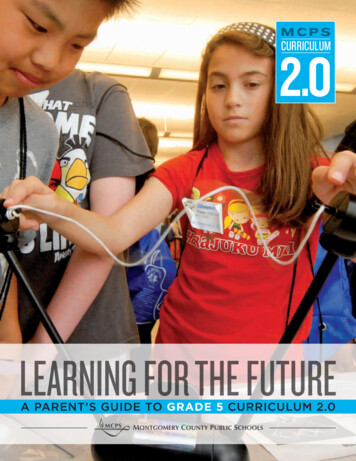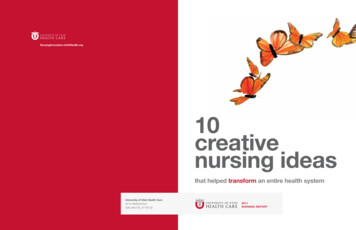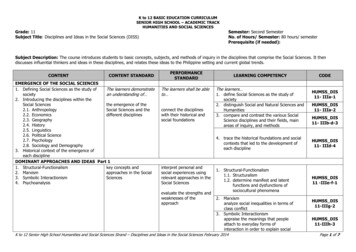
Transcription
K to 12 BASIC EDUCATION CURRICULUMSENIOR HIGH SCHOOL – ACADEMIC TRACKHUMANITIES AND SOCIAL SCIENCESGrade: 11Subject Title: Disciplines and Ideas in the Social Sciences (DISS)Semester: Second SemesterNo. of Hours/ Semester: 80 hours/ semesterPrerequisite (if needed):Subject Description: The course introduces students to basic concepts, subjects, and methods of inquiry in the disciplines that comprise the Social Sciences. It thendiscusses influential thinkers and ideas in these disciplines, and relates these ideas to the Philippine setting and current global trends.CONTENTCONTENT STANDARDEMERGENCE OF THE SOCIAL SCIENCES1. Defining Social Sciences as the study ofThe learners demonstratesocietyan understanding of 2. Introducing the disciplines within theSocial Sciencesthe emergence of the2.1. AnthropologySocial Sciences and the2.2. Economicsdifferent disciplines2.3. Geography2.4. History2.5. Linguistics2.6. Political Science2.7. Psychology2.8. Sociology and Demography3. Historical context of the emergence ofeach disciplineDOMINANT APPROACHES AND IDEAS Part 11. Structural-Functionalismkey concepts and2. Marxismapproaches in the Social3. Symbolic InteractionismSciences4. PsychoanalysisPERFORMANCESTANDARDThe learners shall be ableto connect the disciplineswith their historical andsocial foundationsinterpret personal andsocial experiences usingrelevant approaches in theSocial Sciencesevaluate the strengths andweaknesses of theapproachLEARNING COMPETENCYThe learners 1. define Social Sciences as the study ofsociety2. distinguish Social and Natural Sciences andHumanities3. compare and contrast the various SocialScience disciplines and their fields, mainareas of inquiry, and methodsCODEHUMSS DIS11- IIIa-1HUMSS DIS11- IIIa-2HUMSS DIS11- IIIb-d-34. trace the historical foundations and socialcontexts that led to the development ofeach disciplineHUMSS DIS11- IIId-41. Structural-Functionalism1.1. Structuralism1.2. determine manifest and latentfunctions and dysfunctions ofsociocultural phenomenaHUMSS DIS11 -IIIe-f-12. Marxismanalyze social inequalities in terms ofclass conflict3. Symbolic Interactionismappraise the meanings that peopleattach to everyday forms ofinteraction in order to explain socialK to 12 Senior High School Humanities and Social Sciences Strand – Disciplines and Ideas in the Social Sciences February 2014HUMSS DIS11-IIIg-2HUMSS DIS11-IIIh-3Page 1 of 7
K to 12 BASIC EDUCATION CURRICULUMSENIOR HIGH SCHOOL – ACADEMIC TRACKHUMANITIES AND SOCIAL SCIENCESCONTENTCONTENT STANDARDPERFORMANCESTANDARDLEARNING COMPETENCYbehavior4. Psychoanalysisanalyze the psychodynamics of theperson’s personality in terms of Id,Ego, and SuperegoTHIRD-QUARTER EXAMDOMINANT APPROACHES AND IDEAS Part 26. Rational Choicekey concepts andapproaches in the Social7. InstitutionalismSciences8. Feminist Theory9. Hermeneutical Phenomenology10. Human-Environment SystemsINDIGENIZING THE SOCIAL SCIENCES1. Filipino Social Thinkers2. Institute of Philippine Culture’s study onPhilippine valueskey concepts in the SocialSciences rooted in Filipinolanguage/s andinterpret personal andsocial experiences usingrelevant approaches in theSocial Sciencesevaluate the strengths andweaknesses of theapproachcarry out an exploration ofpersonal and socialexperiences using5. Rational Choicepredict the social consequences ofdecision making based on scarcity6. Institutionalismexamine the constitutive nature ofinformal and formal institutions andtheir actors and how it constrainssocial behavior7. Feminist Theorydetermine the relationship betweengender ideology and genderinequality8. Hermeneutical Phenomenologyanalyze significance of data9. Human-Environment Systems9.1. distinguish the ways by whichhuman-environment interactionsshape cultural and natural landscapes9.2. interpret thematic and mental mapsto understand landscape changes andan individual’s sense of place9.3. explain environmental and socialissues through the analysis of spatialdistributions and spatial processes1. examine the social ideas of Filipinothinkers starting from Isabelo de losReyes, Jose Rizal, and other FilipinoK to 12 Senior High School Humanities and Social Sciences Strand – Disciplines and Ideas in the Social Sciences February 2014CODEHUMSS DIS11-IIIi-53rd quarterexamHUMSS DIS11-IVa-6HUMSS DIS11-IVb-7HUMSS-DIS11-IVc-8HUMSS DIS11-IVd-9HUMSS DIS11-IVd-10HUMSS DIS11-IVe-1Page 2 of 7
K to 12 BASIC EDUCATION CURRICULUMSENIOR HIGH SCHOOL – ACADEMIC TRACKHUMANITIES AND SOCIAL SCIENCESCONTENT3. Sikolohiyang Pilipino4. Pantayong PananawCONTENT STANDARDexperiencesPERFORMANCESTANDARDindigenous conceptsLEARNING COMPETENCY2.3.4.5.SOCIAL SCIENCES IN THE REAL WORLD1. Professions2. Applications and intersections of theapproaches in addressing social problemsthe role of Social Sciencein the real worldillustrate situations andcontexts in which SocialScience can be appliedintellectualsvalue the role of interpersonal relations inPhilippine cultureevaluate the person’s personality using thecore values of Sikolohiyang Pilipinoexplain the significance of using aparticular language for discoursecritique dominant approaches usingFilipino perspectives1. determine how Social Science can be usedto address social concerns2. recognize multidisciplinarity and/orinterdisciplinarity as an approach tolooking at society3. generate an analysis of a socialphenomenon using at least twoapproaches from the Social SciencesFOURTH-QUARTER EXAMK to 12 Senior High School Humanities and Social Sciences Strand – Disciplines and Ideas in the Social Sciences February 2014CODEHUMSS DIS11-IVe-2HUMSS DIS11-IVf-3HUMSS DIS11-IVg-4HUMSS DIS11-IVg-5HUMSS DIS11-IVh-6HUMSS DIS11-IVh-7HUMSS DIS11-IVi-j-84th quarterexamPage 3 of 7
K to 12 BASIC EDUCATION CURRICULUMSENIOR HIGH SCHOOL – ACADEMIC TRACKHUMANITIES AND SOCIAL SCIENCESGLOSSARY1Absolute locationAnthropologyBinary oppositionClass conflictConstitutive natureCore valuesDiscourseEconomicsEgoEnvironmentFeminist theoryFormal institutional constraintGender ideologyGeographyGeographical menologicalHermeneuticsHumanitiesIdInformal institutional constraintThe exact position of an object or place stated in spatial coordinates of a grid system designed for locational purposesThe study of humans; the social science that seeks to understand human origins and adaptation, and the diversity of cultures andworldviewsThe means by which the units of language have value or meaning; each unit is defined against what it is notConflict between entire classes over the distribution of a society’s wealth and powerForming an essential part or a component ofIn Sikolohiyang Pilipino, the core of Filipino personhood is the concept of “kapwa” (shared identity), associated with which areother societal valuesA formal way of thinking expressed through languageA social science that deals with the optimum allocation of scarce resources among its alternatives to satisfy the unlimited humanwants and needs of the peopleThe Freudian structure of personality that deals with the demand of realitySurroundings; the totality of things that in any way may affect an organism, including both physical and cultural conditions; aregion characterized by a certain set of physical conditionsA theory that (1) emphasizes gender as key basis of structured inequality, (2) challenges conventional distinctions between publicand private, and (3) problematizes the fundamentally political relationship between gender and powerRules, procedure, and formal political organizations (such as government)Meanings involved in the assignment of roles for women and men within the household and outside of itThe study of the earth’s surface; a specialized investigation of the physical structure of the earth, including its terrain and itsclimates, and the nature and character of its contrasting inhabited portionsA sensitivity toward the significance of place and space, landscape and nature, in the constitution and conduct of life on EarthA study of the past, one that describes/narrates and analyzes human activities in the past and the changes that these hadundergoneHistorical phenomena (or the world outside) is interpreted differently in proper context through one’s consciousnessThe study of the ways in which the human experience is processed and documented; the fields of philosophy, literature, religion,art, music, history and languageThe part of personality that Freud called “it” consisting of unconscious drives; the individual’s reservoir of sexual energyUncodified rules of conduct such as sanctions, taboos, customs, and traditions that may create and/or sustain temporaryorganizations in potentially underdeveloped/ immature political worldsK to 12 Senior High School Humanities and Social Sciences Strand – Disciplines and Ideas in the Social Sciences February 2014Page 4 of 7
K to 12 BASIC EDUCATION CURRICULUMSENIOR HIGH SCHOOL – ACADEMIC TRACKHUMANITIES AND SOCIAL ary approachLandscapeLatent functionLinguisticsManifest functionMarxismMental mapsMultidisciplinary approachPantayong PananawPlacePolitical sciencePoliticsPsychoanalysisPsychodynamic approachPsychologyRational choiceRegionRelative locationScaleScarcitySiteSituationSikolohiyang PilipinoSocial dysfunctionSocial functionSocial conflict approachSocial ScienceSociologySpatial distributionStructureAn approach that views institutions as humanly devised constraints that structure political, economic, and social interactionsStable, recurring patterns of behavior; hence, political institutions are not the same as political organizationsA method that integrates disciplinary elements and perspectives to create a holistic view or common understanding of a complexissue or problemA term referring to the appearance of an area and to the items comprising that appearanceThe unrecognized and unintended consequence of any social patternThe scientific study of language and its structureThe recognized and intended consequence of any social patternAn approach that acknowledges the economic relations between classes determine/structure soclal and political relationsA map drawn to represent the mental image a person has of an areaA method that puts together separate disciplinary perspectives side by side, adding breadth of knowledge, information, andmethods; disciplines retain their separate perspectives and elements“From-us-for-us perspective”: A communication-based framework whose aim is to produce a "national" discourse (“talastasangbayan”).A human-wrought transformation of a part of the Earth’s surface or of preexisting, undifferentiated spaceThe systematic study of politicsMay be defined as (1) the art of government, (2) public affairs, (3) compromise and consensus, and (4) powerA theory of personality, an approach to psychotherapy, and method of investigation founded by Sigmund FreudAn approach to psychology emphasizing unconscious thoughts of the personThe scientific study of behaviour and mental processesRational choice is a product of scarcity and demand the people to make the right and rational choice to maximize the use of itsresourcesThe term applied to an earth area that displays a distinctive grouping of physical or cultural phenomena or is functionally united asa single organizational unitThe position of a place or activity in relation to other places or activitiesIn cartography, the ratio between length or size of an area on a map and the actual length or size of that same area on the earth’ssurface; the size of the area studied, from local to globalScarcity is a basic problem arising from unlimited wants of people with limited resourcesThe place where something is located; the immediate surroundings and their attributesThe location of something in relation to the physical and human characteristics of a larger regionIs a psychology of, about, and for Philippine peoplesAny social pattern that may disrupt the operation of societyThe consequence of any social pattern for the operation of a society as a wholeAn approach that sees society as an area of inequality that generates conflict and changeThe systematic study of various aspects of human societyThe systematic study of human societyThe arrangement of things on the earth’s surfaceAny relatively stable pattern of social behaviorK to 12 Senior High School Humanities and Social Sciences Strand – Disciplines and Ideas in the Social Sciences February 2014Page 5 of 7
K to 12 BASIC EDUCATION CURRICULUMSENIOR HIGH SCHOOL – ACADEMIC TRACKHUMANITIES AND SOCIAL SCIENCESStructural functionalismStructuralismSuperegoSymbolic interactionismSystems AnalysisThematic maps1An approach that sees society as a complex system whose parts work together to promote soiidarity and stability. It looks for astructure’s social functionA method for analyzing language, narratives, and cultural phenomena that uncovers basic elements that form structures (oftenbinary oppositions)The Freudian structure of personality that serves as the harsh internal judge of our behavior; what we often call conscienceAn approach that sees society as the product of the everyday interactions of individualsAn approach to the study of large systems through (1) segregation of the entire system into its component parts; (2) investigationof the interactions between system elements; and (3) study of inputs, outputs, flows, interactions, and boundaries within thesystemA representation of the spatial distribution of a specific phenomenon (theme) across a geographic areaGeneral References:Barnard, A. (2000). History and Theory in Anthropology. Cambridge: Cambridge University Press.Burnham, P., Gilland Lutz, K., Grant, W., and Layton-Henry, Z. (2008). Research Methods in Politics (2nd Edition). New York: Palgrave Macmillan.Eviota, E. (1992). The Political Economy of Gender: Women and the Sexual Division of Labour in the Philippines . London and New Jersey: Zed Books Ltd.Feist, J., Feist, G., and Roberts, TA. (2013). Theories of Personality (8th Edition). USA: McGraw Companies, Inc.Goodin, R. (1996). “Institutions and their Design”, in R. Goodin (ed.) The Theory of Institutional Design. Cambridge: Cambridge University Press.Getis, Arthur, Judith Getis, and Jerome Fellman (1998) Introduction to Geography, USA: McGraw Hill.Gregory, Derek, Ron Johnston, Geraldine Pratt, Michael Watts, and Sarah Whatmore (2OO9) The Dictionary of Human Geography, UK: Wiley-Blackwell.Heywood, A. (2013). Politics (4th Edition). New York: Palgrave Macmillan.King, L. (2013). Experience Psychology (2nd Edition). USA: McGraw Companies, Inc.Klein, J. (2007). “Interdisciplinary Approaches in Social Science Research”, in W. Outhwaite & S. Turner (eds.) The Sage Handbook of Social Science Methodology. London:Sage Publications.Macionis, J. (2012). Sociology (14th Edition). Singapore; Pearson Education South Asia Pte Ltd.Marsh, D. (2002). “Marxism”, in D. Marsh and G. Stoker (ed). Theory and Methods on Political Science (2nd Edition). New York: Palgrave Macmillan.March, J. and Olsen, J. (1989). Rediscovering Institutions. New York: Free Press.Navarro, A. at Lagbao-Bolante, F. (eds) (2007). Mga Babasahin sa Agham Panlipunang Pilipino: Sikolohiyang Pilipino, Pilipinolohiya at Pantayong Pananaw. LungsodQuezon: C&E Publishing.North, D. (1991). “Institutions.” The Journal of Economic Perspectives, 5(1), pp. 97-112.Randall, V. (2002). “Feminism”, in D. Marsh and G. Stoker (ed). Theory and Methods on Political Science (2nd Edition). New York: Palgrave Macmillan.Schaefer, R. (2001). Sociology (7th Edition). New York: McGraw Hill.K to 12 Senior High School Humanities and Social Sciences Strand – Disciplines and Ideas in the Social Sciences February 2014Page 6 of 7
K to 12 BASIC EDUCATION CURRICULUMSENIOR HIGH SCHOOL – ACADEMIC TRACKHUMANITIES AND SOCIAL SCIENCESCODE BOOK LEGENDSAMPLE CODE:HUMSS DIS11-IIh-2LEGENDSAMPLEHumanities and Social SciencesStrandTrack/ StrandunderscoreFirst EntryTrack/ Strand SubjectDisciplines and Ideas in the Social SciencesGrade Level11HUMSS DIS11Roman Numeral*Zero if no specific quarterQuarterFirst QuarterIILowercase Letter*Put a hyphen (-) in between lettersto indicate more than a specific weekWeekWeek Eighth-Arabic NumberCompetencyGenerate an analysis of a socialphenomenon using at least twoapproaches from the Social SciencesK to 12 Senior High School Humanities and Social Sciences Strand – Disciplines and Ideas in the Social Sciences February 20142Page 7 of 7
K to 12 BASIC EDUCATION CURRICULUM SENIOR HIGH SCHOOL - ACADEMIC TRACK HUMANITIES AND SOCIAL SCIENCES K to 12 Senior High School Humanities and Social Sciences Strand - Disciplines and Ideas in the Social Sciences February 2014 Page 4 of 7 GLOSSARY1 Absolute location The exact position of an object or place stated in spatial coordinates of a grid system designed for locational purposes



